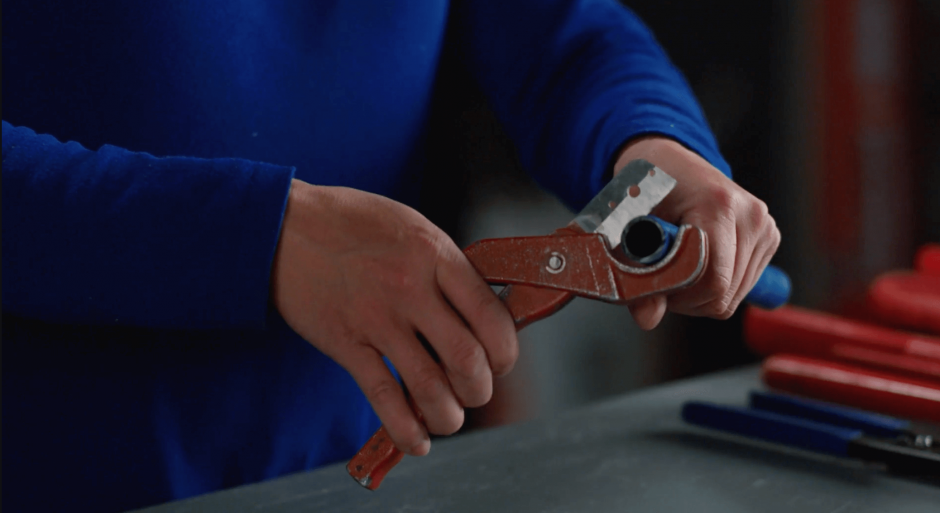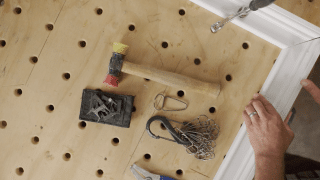
PEX is a flexible plastic pipe that can make long runs without many connections, which reduces the chance of leaks. The flexibility and expandability of the plastic pipe prevents cracking due to freezing temperatures. These features make PEX piping a popular choice in residential plumbing, which many builders prefer over copper or galvanized steel pipes.
What is PEX piping?
PEX pipe or PEX tubing is made of a cross-linked polyethylene plastic, which is a flexible plastic. Because of the versatility of PEX piping, and the fact that it’s flexible and cheap, it’s used for plumbing in both residential and commercial buildings. There are three types of PEX piping: A, B, and C. PEX piping comes in four colors: red, blue, white, and gray. Red is traditionally used for hot water. Blue for cold water. White and gray can be used for both hot and cold water.
In 1968, German scientist Thomas Engel discovered the process of creating the plastic for PEX piping, cross-linked polyethylene. PEX piping caught on quickly in Europe in the 1980s. In the US, however, PEX did not catch on as quickly because PEX did not initially meet US standards for drinking water. It was mostly used at first in the US only for radiant floor heating systems. Once PEX manufacturers made the plastic less susceptible to corrosion from chlorine in drinking water, PEX piping became much more prevalent in the US.
3 Types of PEX piping
There are three main types of PEX piping:
- Type A PEX piping is the most flexible type of PEX piping, making it adaptable for all home water needs, including potable water piping. Type A PEX piping expands most out of the three types, so is most resistant to freezing and cracking, which is important in cold weather climates. While type A PEX is more expensive than the other two types of PEX piping, it is cheaper than copper pipes.
- Type B PEX piping is slightly stiffer and has a robust coil memory, meaning it wants to hold the coiled shape it comes in, making it slightly difficult to install. Type B PEX expands, like Type A, allowing it to resist cracking in cold weather. It is slightly less expensive than Type A and has more resistance to chlorine in water supplies, meaning it won’t break down in areas with a high percentage of chlorine in the drinking water.
- Type C PEX piping is the stiffest of the three and is more prone to kinking and cracking than the other two. It’s often used for short repairs that don’t require any bends. Type C PEX is also usually cheaper than the other two types of PEX piping.
Uses for PEX piping
Plumbers use PEX pipings for both hot and cold potable water. Because PEX piping is flexible, it doesn’t need to be installed using traditional branch piping techniques that require more connections; rather, it can be installed to a central manifold with pipes going directly to the fixtures (called “home runs”). These runs go from the central manifold directly to the fixture, with no fittings or connections. This reduces the number of possible leaks and shortens the installation process. PEX can also be used with traditional branch piping techniques that require more connections.
PEX piping is also used in radiant heat flooring. In this heating system, builders install flexible PEX piping in a zigzag serpentine coil throughout the floor area, and then pour cement over it. Hot water circulates through the PEX pipes in the floor, providing radiant heat to the room.
PEX is a flexible plastic pipe that can make long runs without many connections, which reduces the chance of leaks. The flexibility and expandability of the plastic pipe prevents cracking due to freezing temperatures. These features make PEX piping a popular choice in residential plumbing, which many builders prefer over copper or galvanized steel pipes.
What is PEX piping?
PEX pipe or PEX tubing is made of a cross-linked polyethylene plastic, which is a flexible plastic. Because of the versatility of PEX piping, and the fact that it’s flexible and cheap, it’s used for plumbing in both residential and commercial buildings. There are three types of PEX piping: A, B, and C. PEX piping comes in four colors: red, blue, white, and gray. Red is traditionally used for hot water. Blue for cold water. White and gray can be used for both hot and cold water.
In 1968, German scientist Thomas Engel discovered the process of creating the plastic for PEX piping, cross-linked polyethylene. PEX piping caught on quickly in Europe in the 1980s. In the US, however, PEX did not catch on as quickly because PEX did not initially meet US standards for drinking water. It was mostly used at first in the US only for radiant floor heating systems. Once PEX manufacturers made the plastic less susceptible to corrosion from chlorine in drinking water, PEX piping became much more prevalent in the US.
3 Types of PEX piping
There are three main types of PEX piping:
- Type A PEX piping is the most flexible type of PEX piping, making it adaptable for all home water needs, including potable water piping. Type A PEX piping expands most out of the three types, so is most resistant to freezing and cracking, which is important in cold weather climates. While type A PEX is more expensive than the other two types of PEX piping, it is cheaper than copper pipes.
- Type B PEX piping is slightly stiffer and has a robust coil memory, meaning it wants to hold the coiled shape it comes in, making it slightly difficult to install. Type B PEX expands, like Type A, allowing it to resist cracking in cold weather. It is slightly less expensive than Type A and has more resistance to chlorine in water supplies, meaning it won’t break down in areas with a high percentage of chlorine in the drinking water.
- Type C PEX piping is the stiffest of the three and is more prone to kinking and cracking than the other two. It’s often used for short repairs that don’t require any bends. Type C PEX is also usually cheaper than the other two types of PEX piping.
Uses for PEX piping
Plumbers use PEX pipings for both hot and cold potable water. Because PEX piping is flexible, it doesn’t need to be installed using traditional branch piping techniques that require more connections; rather, it can be installed to a central manifold with pipes going directly to the fixtures (called “home runs”). These runs go from the central manifold directly to the fixture, with no fittings or connections. This reduces the number of possible leaks and shortens the installation process. PEX can also be used with traditional branch piping techniques that require more connections.
PEX piping is also used in radiant heat flooring. In this heating system, builders install flexible PEX piping in a zigzag serpentine coil throughout the floor area, and then pour cement over it. Hot water circulates through the PEX pipes in the floor, providing radiant heat to the room.
What are the advantages of PEX piping?
The flexibility and versatility of PEX piping make it a great option for many plumbers.
- Less leaking. When used in a manifold system, PEX piping limits the possibility of leaks by requiring fewer connections than standard copper piping.
- Less corrosion. PEX piping doesn’t corrode like copper or other metal pipes, meaning drinking water is safe even after many years of use.
- Less expensive. PEX piping is less expensive than copper piping, with even the most expensive Type A PEX piping being significantly less than copper.
What are the disadvantages of PEX piping?
There are a couple of disadvantages to keep in mind before committing to PEX pipes on your project.
- Special tools. Cutting and connecting PEX piping requires special connectors and tools.
- Can break down outside. PEX piping is not suitable for outdoor use. The plastic is subject to breakdown caused by ultraviolet rays. If the pipe is left outdoors, it can harden and crack within a couple of months.
4 ways to join PEX piping
There are many ways to join PEX piping and fittings. All of them require special tools to facilitate the connection.
- Copper crimping: Copper crimping is one of the most common ways to connect PEX piping. In this method, a copper crimping ring slips over the end of a PEX tube and a fitting is inserted inside. A special crimping tool is used to crimp the copper ring on the outside and keep the tube inside in place.
- Expansion connections: A special expander tool is used to stretch the PEX tubing before inserting a fitting. The PEX tube then shrinks back to its original size, creating a watertight seal around the fitting.
- Stainless steel clamps (SSC): In the SSC method, a steel ring is placed over the PEX pipe, and the fitting is inserted inside. A ratchet clamping tool squeezes a tab on the ring, which tightens it securely around the tube and the fitting.
- Push-fit connections: Push-fit connections are the quickest way to connect PEX piping. You simply purchase special fittings that grab the end of the pipe when it’s inserted, similar to a paper finger tube trap. A special removal ring is required to help you remove the pipe once it’s been connected.
MT Copeland offers video-based online classes that give you a foundation in construction fundamentals with real-world applications, like plumbing. Classes include professionally produced videos taught by practicing craftspeople, and supplementary downloads like quizzes, blueprints, and other materials to help you master the skills.







